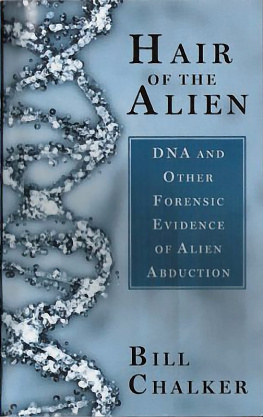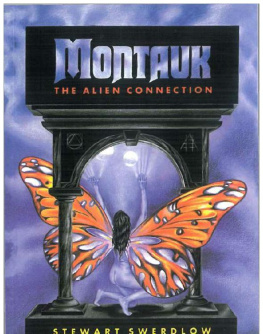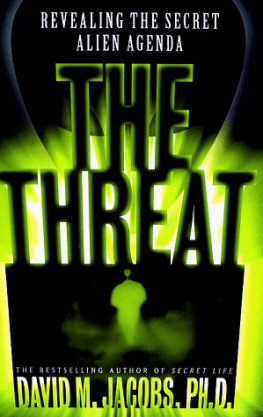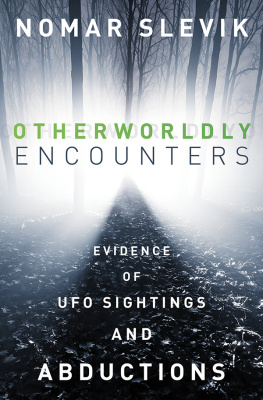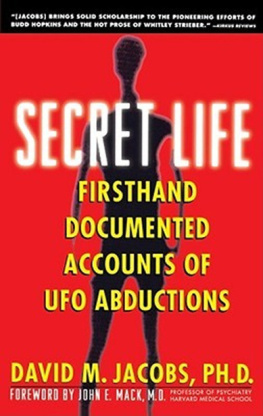Bill Chalker - Hair of the Alien: DNA and Other Forensic Evidence for Alien Abductions
Here you can read online Bill Chalker - Hair of the Alien: DNA and Other Forensic Evidence for Alien Abductions full text of the book (entire story) in english for free. Download pdf and epub, get meaning, cover and reviews about this ebook. year: 2005, publisher: Simon & Schuster, Inc., genre: Detective and thriller. Description of the work, (preface) as well as reviews are available. Best literature library LitArk.com created for fans of good reading and offers a wide selection of genres:
Romance novel
Science fiction
Adventure
Detective
Science
History
Home and family
Prose
Art
Politics
Computer
Non-fiction
Religion
Business
Children
Humor
Choose a favorite category and find really read worthwhile books. Enjoy immersion in the world of imagination, feel the emotions of the characters or learn something new for yourself, make an fascinating discovery.
- Book:Hair of the Alien: DNA and Other Forensic Evidence for Alien Abductions
- Author:
- Publisher:Simon & Schuster, Inc.
- Genre:
- Year:2005
- Rating:4 / 5
- Favourites:Add to favourites
- Your mark:
- 80
- 1
- 2
- 3
- 4
- 5
Hair of the Alien: DNA and Other Forensic Evidence for Alien Abductions: summary, description and annotation
We offer to read an annotation, description, summary or preface (depends on what the author of the book "Hair of the Alien: DNA and Other Forensic Evidence for Alien Abductions" wrote himself). If you haven't found the necessary information about the book — write in the comments, we will try to find it.
Bill Chalker: author's other books
Who wrote Hair of the Alien: DNA and Other Forensic Evidence for Alien Abductions? Find out the surname, the name of the author of the book and a list of all author's works by series.
Hair of the Alien: DNA and Other Forensic Evidence for Alien Abductions — read online for free the complete book (whole text) full work
Below is the text of the book, divided by pages. System saving the place of the last page read, allows you to conveniently read the book "Hair of the Alien: DNA and Other Forensic Evidence for Alien Abductions" online for free, without having to search again every time where you left off. Put a bookmark, and you can go to the page where you finished reading at any time.
Font size:
Interval:
Bookmark:

To all those who have been touched by the alien abduction phenomenon, I hope this work will help anchor your journey in reality, whatever that reality turns out to be.
Entering The Land of Illusion:
Truth becomes fiction when the fictions true;
Real becomes not-real when the unreals real.
Cao Xueqin (c. 1760)
The Dream of the Red Chamber
from the translation by David Hawkes
published by Penguin Classics, 1973, from
The Story of the Stone: Volume 1, The Golden Days
INTRODUCTION

The abduction story that Peter Khoury tells is awash with many of the bizarre features typical of alien abduction stories from around the world.
But his case is spectacularly unique in at least one extraordinary sense. It features a piece of evidence unprecedented in the annals of UFO research and investigation: a very unusual biological sample, a fragment of strange hair to be exact, which in a remarkable but paradoxical way confirmed the truly controversial and provocative nature of the episode that led to its recovery.
This hair sample became the focus of the worlds first DNA investigation of biological evidence implicated in an alien abduction.
I will describe this extraordinary case that has provided us with fascinating genetic evidence, which forms the nexus of a remarkable breakthrough and the cornerstone of this strange odyssey.
With the help of biochemists, I have carried out a thorough forensic investigation of this case, utilizing DNA profiling, coupled with an archaeological-style DNA investigation. The results that have emerged from our work are nothing less than startling.
Hair of the alien? This is no bizarre variant of a hangover cure for UFO obsessions. But it may provide a cure for the lack of physical evidence that has plagued alien abduction research for the past four decades. What we are dealing with here is a fundamental refocusing of our perceptions of alien reality.
There is no doubt that the small bald gray alien is a powerful icon that represents our societys image of an alien life-form.
What is not widely understood, even by many knowledgeable people in the UFO field, is that the dominant image of the bald gray alien is to a great measure an artifact of the popularization of the gray through the efforts of some key researchers, the media, and in particular one prominent abducteea term given to an individual who claims to have had an alien abduction experience.
So pervasive has been the impact of this popularization that the validity of a claim of contact with aliens is now often judged by how closely it conforms to the gray alien stereotype.
But like most stereotyping efforts, the media-driven march of gray conformity is far from the truth and to some extent has misdirected a generation and perhaps delayed a more realistic understanding of the situation.
With its striking image of an alien face on the cover, Communion, Whitley Striebers 1987 account of his claimed encounters with aliens, sold millions of copies and solidified in public consciousness the perception of the alien as bald with large dark eyes. Thousands of accounts describing aliens emerged worldwide in response to this extraordinary public profiling of the alien image.
But Strieber had suppressed one key detail of his alien encounter to see if it would be validated independently in subsequent witness descriptions of alien beings. That detail was the presence of hair in descriptions of aliens.
According to Whitley Strieber, only one case emerged in this human tide of encounters with aliens that strikingly matched his own experiences with aliens, sharing the key element of the presence of hair. That case turned out to be from Australia.
This largely hidden aspect of the alien image may be a potent argument for a sociological dismissal of the whole alien saga, on the grounds that if thousands didnt report it, then the majority may have been delusional or just jumping on the alien bandwagon. Such an argument is found wanting, however, when this suppressed aspect emerges as the central piece of evidence from Peter Khourys encounter, namely the found alien hair that was subjected to DNA testing.
Our current understanding of the alien image has been profoundly skewed. The gray alien icon is clearly not the full picture. Part of that complex and bizarre picture includes beings that are far closer to us in appearance, featuring unambiguously hirsute elements, than we have ever imagined.
What emerges in this investigation is a picture of a phenomenon that redefines our origins and our place in the universe. This investigation goes further than any other before it, because for the first time the fantastic has been anchored in a strange and disturbing reality. After decades of neglect, science is now colliding head-on with the alien abduction controversy.
Whatever is going on, one thing seems clear. These experiences seem to be a form of intrusionan intrusion on our cozy grasp of prosaic realityand if the experiences are real events, the intrusions are a physical assault on the individuals who experience them.
The assumption is that if such experiences are more than imagination, there must be tangible evidence. Knowing what to look for and utilizing the appropriate tools to reveal the nature and implications of that evidence is the key to the problem. Ultimately the application of science, mediated with a forensic focus, will hold the key to determining the reality of alien abduction claims.
Our hunt for clues and answers to this alien mystery features the DNA profiling techniques used by law enforcement organizations such as the FBI and increasingly by police around the world. Such work was made possible only through a remarkable breakthrough, the PCR (polymerase chain reaction) procedure.
Dr. Kary Mullis is credited with the initial concept that led to the PCR technique, a discovery that ultimately earned him the 1993 Nobel Prize in chemistry. The technique rapidly revolutionized biochemistry and opened the way for extraordinary new opportunities for understanding ourselves as a species.
Dr. Henry C. Lee, one of the leading forensic scientists in the United States, and Frank Tirnady, describe the new DNA paradigm in their book Blood Evidence: How DNA Is Revolutionizing the Way We Solve Crimes.
Lee and Tirnady end a long list of striking applications of DNA evidence by noting its ability to resolve contentious public debates and illuminate countless other controversies involving biological issues, both of which are relevant to the controversial issues in this book.
The striking utility of DNA analysis rests on one principal fact. It permits the differentiation of one person from another on a genetic level, Lee and Tirnady explain. It can also distinguish one plant from another, one animal from another, and even one viral or bacterial strain from another.
DNA-identification is predicated upon the genetic uniqueness of each individual (excepting identical twins, triplets, or clones), a uniqueness driven by the engine of sex.
Forensic DNA analysis is not a single technique, Lee and Tirnady point out. It is a swarm of techniques that have been coaxed out of the vast expanse of the human genome... [Most] of the forensic techniques are generally powered by polymerase chain reaction, or PCR, a revolutionary process that permits the faithful reproduction of small, sometimes even vanishingly small, amounts of DNA. The process produces large amounts (identical copies) of DNA... [and] allows investigators to obtain a DNA profile from postage stamps, coffee cups, and even single hairs.
Next pageFont size:
Interval:
Bookmark:
Similar books «Hair of the Alien: DNA and Other Forensic Evidence for Alien Abductions»
Look at similar books to Hair of the Alien: DNA and Other Forensic Evidence for Alien Abductions. We have selected literature similar in name and meaning in the hope of providing readers with more options to find new, interesting, not yet read works.
Discussion, reviews of the book Hair of the Alien: DNA and Other Forensic Evidence for Alien Abductions and just readers' own opinions. Leave your comments, write what you think about the work, its meaning or the main characters. Specify what exactly you liked and what you didn't like, and why you think so.

